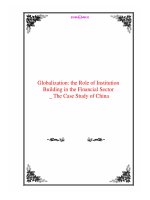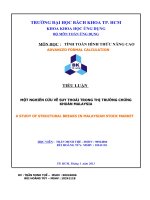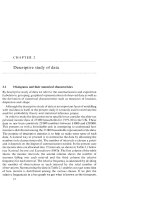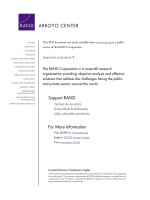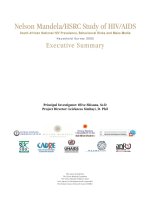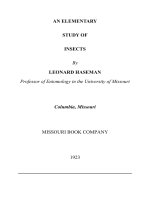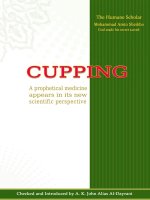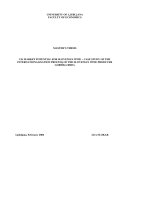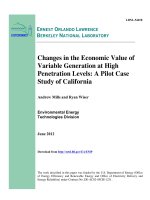Numerical study of suction embedded plate anchor
Bạn đang xem bản rút gọn của tài liệu. Xem và tải ngay bản đầy đủ của tài liệu tại đây (5.16 MB, 233 trang )
NUMERICAL STUDY OF SUCTION
EMBEDDED PLATE ANCHOR
CHEN ZONGRUI
NATIONAL UNIVERSITY OF SINGAPORE
2014
NUMERICAL STUDY OF SUCTION EMBEDDED
PLATE ANCHOR
CHEN ZONGRUI
(B. Eng., HUST)
A THESIS SUBMITTED
FOR THE DEGREE OF DOCTOR OF PHILOSOPHY
DEPARTMENT OF CIVIL AND ENVIRONMENTAL
ENGINEERING
NATIONAL UNIVERSITY OF SINGAPORE
2014
DECLARATION
I hereby declare that the thesis is my original work and it has been written by
me in its entirety. I have duly acknowledged all the sources of information
which have been used in the thesis.
This thesis has also not been submitted for any degree in any university
previously.
_________________
Chen Zongrui
13 August 2014
i
Acknowledgements
First and foremost, I would like to express my deepest appreciation to my
supervisors, Professor Chow Yean Khow and Professor Leung Chun Fai for
their patient guidance, encouragement and critiques of the research. They have
not only introduced me to the field of offshore geotechnics but also have given
me advice and unconditional support throughout my candidature. I would also
like to acknowledge the scholarship as well as all the facilities provided by the
National University of Singapore.
Special thanks to Dr. Tho Kee Kiat, who has introduced me to the ABAQUS
software and help in this research topic. He always been generous with his
time and has constantly been on hand to provide inspiring and fruitful
discussions when needed.
I wish to extend my warmest thanks to all my colleagues for their persistent
friendship and helpful discussions especially Dr. Sindhu Tjahyono, Dr. Sun Jie,
Dr. Saw Ay Lee, Dr. Liu Yong, Dr. Zhao Ben, Dr. Ye Feijian, Dr. Tran Huu
Huyen Tran, Dr. Li Yuping, Dr. Tang Chong, Mr. Hartono and Mr. Yang Yu.
Also, I would like to thank my good friends both in China and Singapore for
their support and accompany. Last but not least, I owe my loving thanks to my
husband, He Hongbo and my whole family for their unlimited love and
support. Without their encouragement and understanding, it would have been
impossible for me to finish this work.
ii
Table of Contents
Acknowledgements i
Table of Contents ii
Summary vi
List of Tables viii
List of Figures ix
List of Symbols xiv
Chapter 1 Introduction 1
1.1 Offshore oil and gas industry 1
1.2 Anchor systems 2
1.2.1 Anchor piles 2
1.2.2 Suction caissons 3
1.2.3 Drag anchors 3
1.2.4 Vertical loaded anchors 4
1.2.5 Suction embedded plated anchors 4
1.2.6 Dynamically penetrated anchors 6
1.3 Suction embedded plate anchor 8
1.4 Objectives and scope of study 9
1.5 Thesis structure 9
Chapter 2 Literature Review 21
2.1 Overview 21
2.2 Uplift capacity of SEPLA 21
2.2.1 DNV design code 22
2.2.2 Analytical solutions and empirical solutions 23
2.2.3 Small strain finite element analysis 24
2.2.4 Limit analysis theorem solutions 25
2.2.5 Large deformation finite element analysis 26
2.3 SEPLA keying process 28
2.3.1 NAVFAC (2012) 29
2.3.2 DNV (2002) 29
2.3.3 Wilde et al. (2001) 29
2.3.4 Song et al. (2005b; 2006; 2009) 30
2.3.5 Gaudin et al. (2006a; 2006b; 2008; 2009; 2010) and O’Loughlin
et al. (2006) 32
2.3.6 Yu et al. (2009) 34
iii
2.3.7 Wang et al. (2011) 35
2.3.8 Yang et al. (2012) and Cassidy et al. (2012) 37
2.4 SEPLA under combined loading 37
2.5 Summary 39
Chapter 3 Finite Element Method 47
3.1 Introduction 47
3.2 Finite element formulations 47
3.2.1 Lagrangian formulation 48
3.2.2 Arbitrary Lagrangian Eulerian (ALE) formulation 49
3.2.3 Smooth Particle Hydrodynamics (SPH) 50
3.2.4 Eulerian formulation 51
3.3 Numerical model 53
3.3.1 Abaqus/Explicit 53
3.3.2 The material model 55
3.3.3 The soil sensitivity 56
3.4 Eulerian finite element model 56
3.4.1 Domain convergence study 58
3.4.2 Mesh convergence study 58
3.4.3 Pullout rate convergence study 59
3.5 Summary 60
Chapter 4 Pullout Behaviour of Square Plate Anchor in Uniform Clay
66
4.1 Introduction 66
4.2 Eulerian finite element model 67
4.3 Comparison of current results and other approaches 69
4.4 Influence of soil overburden 70
4.5 Load-displacement curve during pullout process of plate anchor 74
4.6 Influence of soil rigidity 76
4.7 Conclusion 82
Chapter 5 Pullout Behaviour of Plate Anchor in Clay with Linearly
Increasing Shear Strength 98
5.1 Introduction 98
5.2 Existing studies 100
5.3 Geometry and parameters 103
5.4 Implementation of linearly increasing strength profile in ABAQUS
105
5.5 Effect of soil nonhomogeneity in weightless soil 106
5.5.1 Shape factor 110
iv
5.5.2 Displacement required to mobilize the maximum capacity 111
5.6 Effect of soil overburden ratio 111
5.7 Comparison with current industry practice 114
5.8 Conclusion 116
Chapter 6 Eulerian Finite Element Method to Assess Keying of SEPLA
128
6.1 Introduction 128
6.2 Verification 129
6.2.1 Simulation of SEPLA in normally consolidated Kaolin clay 130
6.2.2 Simulation of SEPLA in uniform transparent soil 133
6.3 Effect of anchor shank 136
6.4 Effect of soil sensitivity in both uniform transparent soil and NC
kaolin clay 139
6.5 Effect of installation and extraction of suction caisson 142
6.6 Parametric studies 143
6.6.1 Effect of anchor unit weight 143
6.6.2 Effect of anchor eccentricity ratio 144
6.6.3 Effect of anchor loading inclination angle 144
6.7 Conclusion 145
Chapter 7 Capacity of Plate Anchor Under Combined Loading 163
7.1 Introduction 163
7.2 Verification 164
7.3 Capacities with soil remolding 168
7.4 Yield locus after keying process of plate anchor 170
7.4.1 Strip plate anchor 171
7.4.2 Square plate anchor 174
7.5 Proposed VHM yield locus for plate anchor under general loading
condition 175
7.6 Conclusion 176
Chapter 8 Conclusions and Recommendations 191
8.1 Introduction 191
8.2 Summary of findings 192
8.3 Recommendations for future studies 195
8.3.1 The effect of aspect ratio 195
8.3.2 Long-term capacity and behaviour of SEPLA 195
8.3.3 Interaction of the SEPLA and mooring line 196
8.3.4 Out of plane loading 196
Reference 198
v
List of publications 204
vi
Summary
A cost efficient and reliable mooring system is required for the floating
production system for oil and gas exploration and production. Suction
embedded plate anchor (SEPLA) is a viable deep water mooring system due to
advantages in terms of low cost, accurate positioning, short installation time
and high efficiency. It has been available since 1998 but the behavior of
SEPLA still warrants further investigation if they are used for permanent
mooring. The objective of this thesis is to address issues related to the
application of SEPLAs as a permanent mooring system.
The Eulerian finite element method is ideal for analyzing problems involving
large deformation in geotechnical engineering. Mesh distortion does not occur
despite the material undergoing large deformation. First, the Eulerian large
deformation finite element analysis was conducted in ABAQUS to study the
pullout behaviour of SEPLA in uniform clay and in clay with linearly
increasing shear strength. A new kind of flow mechanism during the pullout of
square plate anchor is defined in this thesis as the partially full flow
mechanism. An approach to predict the uplift capacity of plate anchor under
different combinations of embedment ratio, overburden pressure and soil non-
homogeneity is proposed. Second, the keying process and the effect of
installation were also assessed by the Eulerian finite element approach.
Factors affecting the loss of embedment during the keying process and the
final anchor capacity such as anchor contact behaviour, anchor geometry, soil
vii
sensitivity, installation method as well as pullout angle are investigated to
enhance the confidence of using SEPLA as a permanent mooring system. The
effect of the soil sensitivity is minor for the loss of embedment compared to
other factors but it reduces the anchor short-term capacity. The loss of
embedment increases with decreasing anchor eccentricity ratio when the
eccentricity ratio is less than 0.5. The pullout angle has minimal effect on the
ultimate anchor resistance but it affects the loss of embedment. The thesis also
extends the study on the behavior of SEPLA under sole vertical pullout to
combined vertical, horizontal and moment loadings. Due to the remolding of
the soil and change of SEPLA configuration during the keying process, the
size of the yield locus for short-term capacity is much smaller than the wish-
in-place horizontal plate although the shape of the yield locus remains quite
similar. An improved yield locus for plate anchor under general loading
condition after the keying process under short-term condition considering the
remolding of the soil is proposed.
viii
List of Tables
Table 1.1 Top 20 producing blocks for the years 2006-2007 in the Gulf of
Mexico (OCS Report, MMS 2009-016). 11
Table 1.2 Types of anchors (Randolph et al., 2005) 11
Table 1.3 Advantages and disadvantages of different anchor types (Ehlers et
al., 2004) 12
Table 3.1 Convengence studies for domain size and mesh 61
Table 5.1 Combinations of dimensionless groups for parametric studies 118
Table 6.1 Summary of studies for strip plate anchor in normally consolidated
kaolin clay 147
Table 7.1 Comparison of the capacity factor under purely vertical / horizontal /
rotational load for strip plate anchor 177
Table 7.2 Parameters for the yield envelop 177
ix
List of Figures
Figure 1.1 Comparison of average annual shallow-and deepwater oil and gas
production (OCS Report, MMS 2009-016). 13
Figure 1.2 Floating systems (Leffler et al., 2003) 14
Figure 1.3 Anchor piles (Vryhof, 2010) 14
Figure 1.4 Suction caisson () 15
Figure 1.5 Drag anchor (Vryhof, 2010) 16
Figure 1.6 Vertical loaded anchor (Vryhof, 2010) 16
Figure 1.7 (a) Photograph of typical SEPLA Anchor and (b) Schematic of
SEPLA (Brown et al., 2010) 17
Figure 1.8 Installation process for Suction embedded plate anchor(Gaudin et
al., 2006b) ① suction installation ②caisson retrieval ③anchor keying ④
mobilized anchor. 18
Figure 1.9 Torpedo anchor (Medeiros Jr, 2002) 19
Figure 1.10 Installation procedure for torpedo anchor (Lieng et al., 2000) 20
Figure 2.1 Conditions of cavity expansion (Yu, 2000) 41
Figure 2.2 Definition of “k4”failure (Rowe and Davis, 1982) 41
Figure 2.3 Capacity factor versus aspect ratio (Wang et al., 2010) 42
Figure 2.4 Anchor loading system during keying process (Song et al., 2009) 42
Figure 2.5 Interface roughness effect on anchor keying (vertical pullout) (Song
et al., 2009) 43
Figure 2.6 Geometrical notation of plate anchor (O'Loughlin et al., 2006) 43
Figure 2.7 Plate anchor inclination during pull out (Gaudin et al., 2008) 44
Figure 2.8 Loss of embedment during keying (Gaudin et al., 2008) 45
Figure 2.9 Loss of embedment of anchors featuring keying flap (Gaudin et al.,
2010)(Anchor without keying flap is applied for Gaudin et al., 2009) 45
Figure 2.10 Numerical setup for anchor and mooring chain (Yu et al., 2009) 46
x
Figure 3.1 Schematic comparisons of Lagrangian, ALE and Eulerian
formulations 62
Figure 3.2 Tresca yield surface in principal stress space 63
Figure 3.3 Schematic of the quarter model for pullout capacity of square plate
anchor of width B 64
Figure 3.4 Uplift load (F) versus normalized displacement (w/B) curves for
convergence study (Anchor width B=0.5m, embedment ratio H/B=5) 65
Figure 4.1 Finite element model for pullout capacity of circular plate anchor 85
Figure 4.2 Normalized uplift load (F) versus displacement (w) responses for
circular anchors in weightless soil (Anchor diameter D=0.5m, embedment
ratio H/D=4) 85
Figure 4.3 Capacity factors N
c
obtained from different methods for anchors
with different embedment ratio in weightless soil (H is the anchor embedment
depth, B is the width of the plate anchor) 86
Figure 4.4 Effect of overburden pressure for square anchors in uniform clay
(E/s
u
=500,
γ
is the clay unit weight, H is the plate embedment depth, B is the
plate width) 86
Figure 4.5 Velocity field for different types of failure mechanisms 88
Figure 4.6 Failure mechanism for different overburden ratios 89
Figure 4.7 Normalized load versis depth below ground surface/B curves
during pullout process for different anchor embedment ratios 90
Figure 4.8 Soil configuration when plate is pulled to soil surface 91
Figure 4.9 Domain convergence study (H/B=7, E/s
u
=10000) 91
Figure 4.10 Effect of the pulling rate on the soil rigidity 92
Figure 4.11 Effect of soil rigidity index for different failure mechanisms 94
Figure 4.12 Normalized load (F)-displacement (w) curve at H/B=6 94
Figure 4.13 Effect of overburden pressure for square anchors in uniform clay.
(a) Capacity factors corresponding to E/s
u
=200 and (b) Capacity factors for
E/s
u
=200 and 500 for H/B=1, 3 and 7. 95
Figure 4.14 Effect of H/B and
/
u
Hs
γ
on capacity factor for square plate
anchors. 96
Figure 4.15 Relationship between capacity factor and E/s
u
(H/B=7) 97
Figure 5.1 Soil undrained shear strength profile 119
xi
Figure 5.2 Variation of N
coρ
against H/B for strip plate anchor 119
Figure 5.3 Uplift load-normalized anchor elevation plots for H/B=2 (B=4m)
120
Figure 5.4 Comparison of failure mechanisms for H/B=2 120
Figure 5.5 Uplift load-normalised anchor elevation plots for H/B=7 (B=4m)
121
Figure 5.6 Comparison of failure mechanisms for H/B=7: (a) uniform soil at
uplift displacement w/B=2, (b) the nonhomogeneous soil at uplift
displacement w/B=2 121
Figure 5.7 Soil undrained shear strength contour for Model 2 122
Figure 5.8 Capacity factors for various embedment ratios with different soil
inhomogeneity in weightless soil 122
Figure 5.9 Variation of shape factor S
c
versus H/B for square anchors (
,0
/1
u
kB s =
) 123
Figure 5.10 Comparison of uplift displacements at ultimate anchor capacity
for uniform and nonhomogeneous soils 123
Figure 5.11 Parametric studies for capacity factor 124
Figure 5.12 Comparison of results from current study with those obtained
from direct summation up to limiting value approach 125
Figure 5.13 Soil flow mechanism at the displacement w/B=2 ((a) H/B=10,
,0
/
u
kB s = ∞
,
,0
/( ) 0
u
H s kH
γ
+=
; (b) H/B=10,
,0
/
u
kB s = ∞
,
,0
/( ) 8
u
H s kH
γ
+=
) 126
Figure 5.14 The relative error for (a)
,0
/1
u
kB s =
and (b)
,0
/
u
kB s = ∞
127
Figure 6.1 Normalized anchor displacement versus anchor inclination 148
Figure 6.2 Geometry of anchor in Song et al. (2006) experiments 149
Figure 6.3 Eulerian finite element model for the keying process of square
plate anchor in uniform transparent soil 149
Figure 6.4 Loss of embedment versus anchor inclination for uniform
transparent soil 150
Figure 6.5 Mooring line configuration during keying (1: At the initial stage; 2:
During the keying process; 3: At the end of the keying process) 151
Figure 6.6 Geometry of anchor with shank 151
xii
Figure 6.7 Normalized load-displacement relationships 152
Figure 6.8 Soil flow mechanism for anchor without shank during the anchor
keying process 153
Figure 6.9 Soil flow mechanism for anchor with shank during the anchor
keying process 154
Figure 6.10 Effect of soil sensitivity in uniform transparent soil 155
Figure 6.11 The effect of soil sensitivity in NC kaolin clay (e/B=0.5) 156
Figure 6.12 Soil flow mechanism during the anchor keying process in NC
Kaolin clay 157
Figure 6.13 SEPLA installed by different methods 158
Figure 6.14 Effect of anchor unit weight 159
Figure 6.15 Effect of anchor eccentricity ratio 160
Figure 6.16 Effect of anchor pullout inclination 162
Figure 7.1 Geometry of strip plate anchor (O'Neill et al., 2003) 178
Figure 7.2 Configuration of Eulerian finite element model 178
Figure 7.3 Interaction curves for strip plate anchor with B/t=7 180
Figure 7.4 Normalized load-displacement curves for plate anchor under purely
vertical load 181
Figure 7.5 Revolution of remolding zone during pure vertical pull out 182
Figure 7.6 Load-displacement curves for plate anchor under purely horizontal
load 183
Figure 7.7 The revolution of the remolding zone during the purely horizontal
pull out 183
Figure 7.8 Load-displacement curve for plate anchor under purely rotational
load 184
Figure 7.9 The remolding zone during the rotation at radian of 0.785 (≈45°)
184
Figure 7.10 Sketch of configuration of plate anchor 185
Figure 7.11 Local coordinate system for inclined plate anchor 185
Figure 7.12 Interaction curves for strip plate anchor with B/t=7 187
xiii
Figure 7.13 Comparison of soil remoulding in the vicinity of SEPLA for
different reference points (a)load reference point at the center of the fluke
(b)load reference point at the anchor padeye 188
Figure 7.14 Interaction curves for square plate anchor with B/t=20 190
xiv
List of Symbols
A
Section area of plate anchor
B
Width of the plate anchor
C
θ
Constant which varies with anchor geometry
d
Chain diameter
D
Diameter of the circular plate anchor
e
Anchor padeye eccentricity
f
e
Anchor shank resistance eccentricity
w
e
Anchor shank weight eccentricity
n
E
Multiplier giving the effective chain width in the direction
normal to the chain
E
Young’s modulus
f
Anchor shank resistance
F
Resistance of plate anchor
V
F
Total vertical force
H
F
Total horizontal force
s
F
Force component applied normal to the plate
n
F
Force component applied parallel to the plate
i
F
External applied forces
1
H
Horizontal offset load
max
H
Maximum horizontal load
H
Plate anchor embedment depth
i
I
Internal element forces
o
K
Lateral stress coefficient
k
The gradient of undrained shear strength
1k
Interaction factor
xv
k
θ
The gradient for the curve fitting (
k
θ
=0.005 degree for all
anchors)
L
Length of the plate anchor
m
Ratio of the influence zone divided by the embedment depth
(
1m =
for clay when the pullout limit pressure is equal to the
internal cavity pressure)
1m
Interaction factor
2m
Interaction factor
max
M
Maximum bending moment
M
Total bending moment
o
M
Initial moment corresponding to zero net vertical load on the
anchor
1
M
Bending moment offset laod
2
M
Bending moment in out-of-plane direction
n
Interaction factor
c
N
Capacity of plate anchor
n
N
Normal capacity factor
s
N
Parallel capacity factor
m
N
Rotational capacity factor
N
coρ
capacity factor for weightless soil with strength linearly
increasing with depth
co
N
Capacity factor for weightless soil
c
N
γ
Capacity factor for soil with unit weight
p
Pullout ultimate pressure
0
p
Initial soil pressure
1p
Interaction factor
lim
p
Limiting pressure
Q
Pulling resistance offered by the surrounding soil
q
Bearing pressure
1q
Interaction factor
xvi
s
Interaction factor
,0u
s
Soil undrained shear strength at the mudline
0u
s
Soil undrained strength in the undisturbed soil
u
s
Soil undrained shear strength
,u avg
s
Average undrained shear strength across the anchor plate
embedment depth after keying
c
S
Shape factor
T
Torsion
t
Plate anchor thickness
∆u Horizontal displacement of plate anchor
max
V
Maximum vertical load
1
V
Vertical offset load
'
a
W
Difference between the anchor weight in air and the anchor
buoyancy force in soil
Y
Yield stress
α
Friction coefficient
β
Plate anchor inclination to the horizontal
γ
Soil saturated unit weight
η
Empirical reduction factor
a
θ
Angle of force at the padeye to the horizontal
z∆
Loss of embedment during keying
u∆
Horizontal displacement of plate anchor
θ
Anchor pullout angle in degree
µ
Chain-soil frictional coefficient
i
u
Acceleration
1
σ
Maximum principal stress
3
σ
Minimum principal stress
rem
δ
Fully remoulded strength ratio (the inverse of the sensitivity)
ξ
Cumulative shear strain
